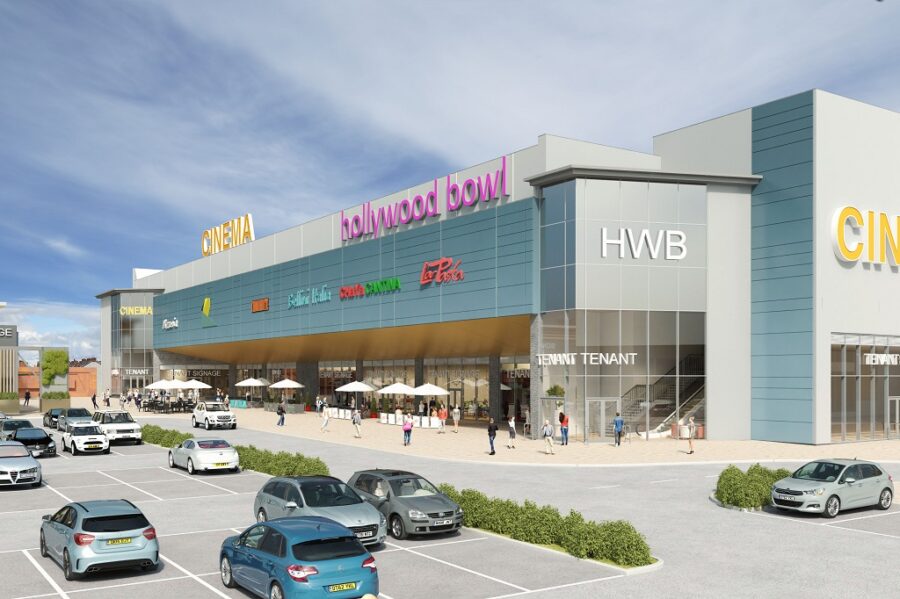‘Opportunities endless’ as AEW looks to next phase
In its 27-year history, AEW Architects has seen a raft of changes, brought about by foreseen, and unforeseen circumstances. Place North West sat down with managing director Andy Critchlow, alongside directors Andy Rainford and Colin Savage, to discuss the next phase for the business.
Founded in 1992, AEW is based in Manchester, with 65 staff delivering services such as design, masterplanning and BIM, across sectors including residential, industrial, retail, offices, sport and leisure. Historically known for its industrial or out-of-town retail projects for clients such as Peel and Derwent, the past few years have seen an expansion into town centre regeneration work in Burnley, Bolton, and Stockport, as well as office projects, such as in Crewe for Radius and Wrexham for Moneypenny. Turnover is set to reach £6.5m this year.
One of the saddest and most significant events for the practice was the death of former managing director Steve Burne. Burne had led the business alongside Critchlow and Nigel Machin following a management buy-out in 2011. After a terminal cancer diagnosis in 2017, Burne exited the business to focus on treatment, and passed away last October.
Critchlow acknowledged the past couple of years had been “a sensitive time”.
“Steve was such a well-known figurehead in the market, and going through a period of terminal illness we needed to be very sensitive, both to the individual and in our business decisions in order to be sensitive to everyone else .
“We’re about putting people first, so as soon as he was diagnosed, the priority was getting him out of the business so he could get treatment and focus on that. Any business concerns were taken off him to give him the time to invest in himself, and we put practices in place so he didn’t see any pressure.
“Even in the most dire circumstances, Steve was putting the business first and ensuring succession was being thought of.”
Last year also saw the departure of fellow director Nigel Machin, who left in August to join long-standing client Derwent Group, leaving Critchlow with 100% ownership.

AEw projects include Liverpool Shopping Park for Derwent, where Machin is now director
However, Critchlow had no inclination to run AEW solo, so the coming weeks will see Rainford and Savage come on board as minority shareholders.
“It’s down to the culture in which you’ve always worked. AEW has never been headed by a single person, it’s never been one person’s brainchild, it’s a collaborative approach,” Critchlow explained.
“The idea of maintaining and orchestrating control has never been in my psyche, and it’s been about sharing the opportunities available in the business, and mitigate any single person’s risk.”
Burne’s illness and Machin’s departure coincided with AEW’s 25th anniversary, what would have been a natural time to evolve the business, however changes were put on hold while the leadership team changed and adapted to the absence of Burne. In the past few months, AEW has seen an overhauled office, rebrand, other promotions, and the recruitment of Phil Sayle from Eric Wright as business development manager.
According to Rainford, “the business needed a refresh”.
“it’s what Steve would have wanted, for us to grow and succeed. It’s a testament to his legacy, that there’s a strong business plan and strong structure in place.”
Each director takes care of a separate stream of the business, however Critchlow said that “the logic is, it’s all connected, if we’re investing in people, we should turn out the best projects, and then if we have that sorted then performance should really look after itself.”
With a specialism in residential and social housing, Savage’s recruitment in 2017 brought new experience to the practice’s more established teams, and since joining, AEW has won places on four frameworks, for social and affordable housing, as well as increasing the volume of projects in this field with clients such as Trafford Housing Trust.

AEW project for Trafford Housing Trust in Sale
For Savage, AEW’s expanded residential offer hasn’t just acted as a separate work stream to the rest of the office. “We’ve seen a combining with existing commercial clients, so putting the two together has been very interesting. Particularly, commercial clients with landholdings looking to do other things with their stock, which adds to the work we’re doing increasingly with registered providers who need to do a lot more, be self-sufficient, and look at different ways to bring income.” Overall, AEW has 500 residential units on site, across different tenures, and a further 600 in the pipeline.
According to Rainford, the company has been intentionally diversifying its projects, but part of the battle has been perception.
“Historically, we’ve been very retail focused, and at peak, retail has been 65% of workload for the company, although externally perception may have been that we had more of an industrial focus. We’re now being a bit more targeted, growing that retail and industrial offer, but also looking at mixed-use, residential, and increased commercial developments. We’re not over-exposed in the city centre residential market, and we’re looking to be more active in peripheral towns.”
“Blurring the different sectors we operate in represents a blurring in the market,” added Critchlow. “It’s inconceivable to talk about a retail only, any scheme will have to have leisure in there, backed up by residential. Occupiers and employees are demanding retail space on their front door. Schemes need to be drawn from a variety of different component parts to be successful.”
Ensuring all schemes are held to a high standard, from sheds to offices and homes, is central to AEW, said Critchlow: “Some of our great projects could be big, rather dull-looking industrial sheds to other practices, but if we maximise the benefit of that to provide good employment space to the community in which it’s being built, and have brought good design solutions, then that’s a great project for us.
Commenting on AEW’s reputation as a delivery architect, he said: “We’ve previously talked ourselves down and beaten ourselves up about what the market thinks of us, but I’m proud that clients and contractors will come to us to deliver a project because of our technical expertise. But that’s not at the detriment to our design reputation.”

AEW is advising Muse on the £150m Church Wharf in Bolton
While AEW has a good regional spread of projects, historically it’s had fewer schemes in central Manchester. Work has included King Street Townhouse and a residential project for Glenbrook on Ellesmere Street, but is the practice looking to do more?
“We continue to bang on the door in Manchester, and deliver good schemes anywhere else. We can work in London across from the Houses of Parliament, or in Stockport across from the Town Hall, so would love to get the opportunities to do that kind of work in Manchester,” said Rainford. “But it’s incumbent on us to go out there, keep doing great work, and talk to people we haven’t done work with before.”
Asked about perpetual challenges for architects, of bidding for projects on frameworks, and facing pressure to deliver work speculatively, Critchlow said that while some frameworks had the right sentiment, many didn’t provide “a level playing field”.
“Some of the scenarios you pitch against on frameworks are make believe situations. Some people then pitch low numbers, because they know reality is not going to be anything like what they’ve priced, but they get their foot in the door, which is a cynical way of dealing with it.”
According to Rainford, AEW was firm that “we’re not entering into a race to the bottom with fees, we can’t compete with a two-man band, we’ve got to be profitable and be able to invest in our people, create the right environment and product. It’s not about being uncompetitive, but about not cutting our own throats. You can run around being busy fools, and not making much money.”
Overall, the practice was seeing “less pressure for large-scale speculative work. A lot of our clients talk about fees early on in projects, something which has changed recently.”
As AEW moves into its next phase, for Critchlow, his priority is “a focus on continual improvement, internally and externally.
“I’m a huge fan of British Cycling, and Team Sky’s 1% marginal gains, where everything is about, don’t beat yourself up about if you’ll be perfect tomorrow, but if you make a slight improvement to how you were today, you’re going in the right direction.
“If everyone in the company is doing that, then the opportunities are endless.”




